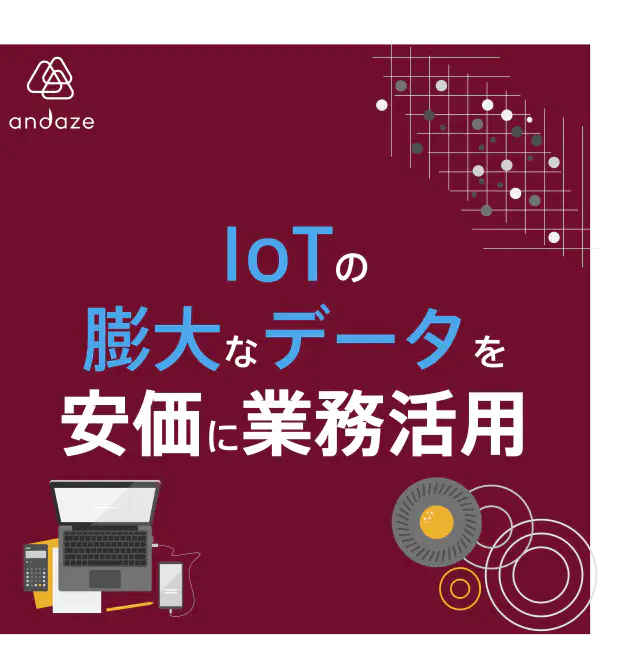
IoT/Big Data Development Services
Andaze Ltd. provides big data development services that lead to corporate profitability, from automatic collection of in-house data using various tools and devices to processing and analysis. Andaze has a wealth of experience in IoT applications, so you can trust your big data development, which has the potential to become a major corporate asset, to Andaze.Supporting data utilization that leads to business innovation and new business opportunities
Examples of IoT/Big Data development Andaze has worked on
IoT/Big Data Development Services
Supporting data utilization that leads to business innovation and new business opportunities
With the promotion of DX, an increasing number of companies are seeking to “successfully link the large amount of data (Big Data) they possess to their business”. This data is useful in understanding the current situation and making accurate judgments based on it, without relying on human experience and intuition. By referring to predictive analysis of big data and linking it to operational reforms and the creation of new businesses, we will realize the establishment of DX and a shift to “data-driven management,” in which management is conducted while making use of data.
Andaze provides big data development services that lead to corporate profitability, from the automatic collection of internal data using various tools and devices to processing and analysis. The results of this analysis can lead to explosive effects, such as improved productivity and quality control. Andaze has extensive experience in IoT applications, so you can trust your big data development, which has the potential to become a major corporate asset, to Andaze.
●Efficient data collection methods
There are many ways to collect data, but choosing a less labor-intensive method will help establish system use. For example, the automatic acquisition of data from POS, IoT, and MtoM (a system in which machines are directly networked and exchange data with each other, such as sensors, GPS, and communication devices) is very effective and does not require human intervention.
●Structured, semi-structured, and unstructured data
There are three types of data that make up big data: “structured data” in tabular form with rows and columns, “semi-structured data” in tabular form with certain regularity in content, and “unstructured data” with no regularity in content. Unstructured data" and “semi-structured data” make up the bulk of big data, and large storage capacity is required to capture and utilize them regardless of data format or volume. Andaze will build an inexpensive data lake in the cloud, accumulate large volumes of data, and process them into data suitable for analysis.

●"Three-tier data processing design" to process data for analysis
At Andaze, a wide variety of raw data collected in the data lake is processed using the “three-layer data processing design” (medallion architecture) that has been the focus of much attention recently. By processing in the order of first layer, second layer, and third layer, the structure and granularity of the data becomes more purposeful.
・The first layer “stores” the raw data
The first layer is unprocessed raw data, where data collected by various means is stored as is (in native data format), regardless of requirements. The mixture of structured and unstructured data and the large data volume require low-cost, scalable storage. Since the data in the first layer is not cleansed, it cannot be used as is.
・Perform “minimal data processing” at the second layer
The first layer of data is matched, merged, filtered, and cleansed (at a moderate level) into conformant data with well-formed strings, numbers, dates, etc. Key business entities and transactional data can be extracted, allowing for self-service analysis by business departments and making it a suitable data source for AI.
・The third layer is “data processing for the purpose”
The third layer is to process the data to a level that meets business requirements and can be read and visualized by BI tools. Processed data is at a level that can be used as-is for BI analysis, reporting, presentations, etc. In addition, the data is normalized with a proxy key so that the business department can perform self-service data aggregation.
Examples of IoT/Big Data development Andaze has worked on
The manufacturing and logistics industries are increasingly adopting IoT, and big data is being actively utilized. For example, sensors are used to monitor the status of people and goods and take early countermeasures when anomalies are detected.
Construction of internal information aggregation infrastructure (data lake, three-tiered database)
Vehicle Location Information Management System
Detection system for defective products, scratches and dents on containers in the manufacturing industry
AI-OCR-based character identification and detection system for packing boxes, etc.
AI (Artificial Intelligence)," “Machine Learning” and “Deep Learning,” which are often mentioned in conjunction with Big Data, are also Andaze’s areas of expertise. Please contact us for more information.
Solution
Free PDF Book “PaaS-no-Susume”
Technology to “cheaply create” sustainable systems (FY2022 Edition)
Are you looking for information about inexpensive and flexible system development, but are having trouble pinpointing any of them? This publication shares how we have used PaaS to solve our clients’ problems and make their IT investments successful.
- How to Reduce SaaS License Fees and Reach Advanced Data Utilization
- How to Procure PaaS Databases for Better Return on Investment
- What is sustainable DX that can keep up with business changes?
This 100+ page guide explains in detail how to create a sustainable system using PaaS and what you need to know in advance. We hope you will find it useful in your company’s DX efforts.



